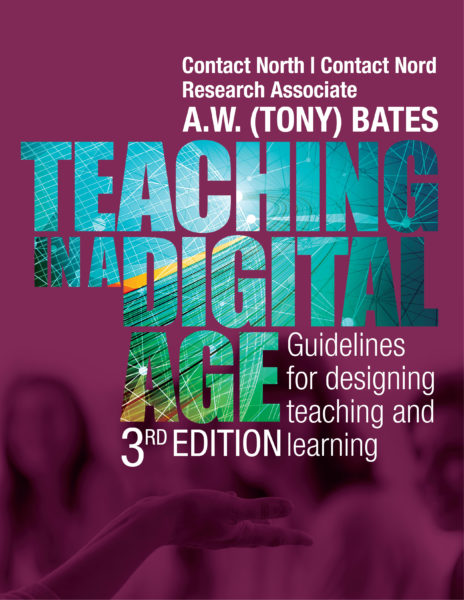Teaching in a digital age requires a new approach because of changes in the economy and changes in technology.
Faculty and instructors are continually facing questions such as how do I effectively teach an increasingly diverse student population, how do I engage and support my students as class sizes increase, how do I use multi-media and other resources to build a high quality course, and a host of other questions.
Drawing on his 40+ years of experience in higher education in Canada and around the world, Contact North | Contact Nord Research Associate Dr. Tony Bates has authored a comprehensive, easy-to-read guide that answers these questions and many, many more all in a single location.
Through 14 informative chapters, the third edition of Teaching in a Digital Age: Guidelines for Teaching and Learning answers your questions and provides helpful guidance and suggestions on a host of topics including:
- How do I decide whether my courses should be campus-based, blended or fully online?
- What strategies work best when teaching in a technology-rich environment? What methods of teaching are most effective for blended and online classes?
- How do I make choices among all the available media, whether text, audio, video, computer, or social media, in order to benefit my students and my subject?
- How do I maintain quality of teaching, learning, and resources in a rapidly changing learning environment?
- What are the real possibilities for teaching and learning using MOOCs, OERS, open textbooks?
- What was the impact of Covid-19 on teaching and learning and what lessons can we learn from this?
While understanding and respecting the individual nature of teaching, Tony talks theory, options, best practices, point-by-point strategies – offering clear, practical, and actionable advice and guidance based on research and best practices.
Pick one chapter or read them all – you will find a wealth of information at your fingertips.
Teaching in a Digital Age: Guidelines for Teaching and Learning is available as a free, online open textbook. The English version is available for reading in the following versions:
- online website
- epub
- print on demand (there will be a cost for printing and delivery)
Go to the book website to choose your version.
Translations
The following translations for the third edition are available:
Spanish
Enseñar en l’era digital, translated by CETEC, Facultad de Ingeniería, Universidad de Buenos Aires
French
L’enseignement à l’ère numérique, translated by a team from the Département des sciences de l’éducation, Université de Québec à Trois-Rivières
The following translations of the first edition are available:
Vietnamese:
Dạy học trong kỷ nguyên số, translated by Lê Trung Nghĩa, Development Co-ordination Agency for Environment of Science and Technology (DCA), Ministry of Science and Technology of Vietnam.
Also available in Vietnamese from BC Open Textbooks as a pdf or editable file
French:
L’enseignement à l’ère numerique: des balises pour l’ensignement et l’apprentissage, translated by Contact North|Contact Nord (pdf only)
Also available in French (pdf only) from BC Open Textbooks
Spanish:
La Enseñanza en la Era Digital: una guià para la enseñanza y el aprendizaje, translated and adapted by the Centre for Distance Education, la Facultad de Ingeniería, Universidad de Buenos Aires, Argentina (pdf only)
Chinese:
数字化时代的教学 The Chinese translation is by Liu Yongquan, Beijing Open University and is published by the Chinese Central Radio and TV University Press Co Ltd. There is a pdf version available for free downloading or a print copy can be ordered online.
Portuguese:
Portuguese translation by ABED (Brazilian Association of Distance Education), Brazil, available in a fully printed format from ABED.
Turkish
Turkish translation by Muge Adnan, Distance Education Centre, Mugla SK University, and Yasemin Gulbahar, Distance Education Centre, Ankara University, Turkey
Arabic translation by Nahed Ghoneim, Faculty of Education, Menoufia University, Egypt – completion date open.
Farsi
Farsi translation by Mohsen Keshavarz, Director of Medical Education Development Center at Torbat Heydariyeh University of Medical Sciences and Afsaneh Sharif, Faculty Liaison at UBC – first five chapters




 Dr. Tony Bates is the author of eleven books in the field of online learning and distance education. He has provided consulting services specializing in training in the planning and management of online learning and distance education, working with over 40 organizations in 25 countries. Tony is a Research Associate with Contact North | Contact Nord, Ontario’s Distance Education & Training Network.
Dr. Tony Bates is the author of eleven books in the field of online learning and distance education. He has provided consulting services specializing in training in the planning and management of online learning and distance education, working with over 40 organizations in 25 countries. Tony is a Research Associate with Contact North | Contact Nord, Ontario’s Distance Education & Training Network.